Intellectual Property Law in India: Emerging Trends and Issues
VerifiedAdded on 2020/01/07
|8
|1735
|151
Essay
AI Summary
This essay provides a comprehensive overview of Intellectual Property Law (IPL) in India, exploring its historical context, evolution, and significance in the modern era. It delves into various aspects of IPL, including copyrights, trademarks, patents, and geographical indications, highlighting their roles in protecting creative works and commercial innovations. The essay examines emerging trends in IPL, such as the impact of new technologies and globalization, and discusses contemporary issues like anti-competitive practices, plagiarism, and the challenges of digital copyright. It also analyzes the role of the Indian government in protecting IPL, emphasizing the need for international cooperation, effective enforcement mechanisms, and the promotion of a conducive environment for innovation. The conclusion underscores the importance of IPL protection for fostering economic growth and encouraging creative endeavors in India.
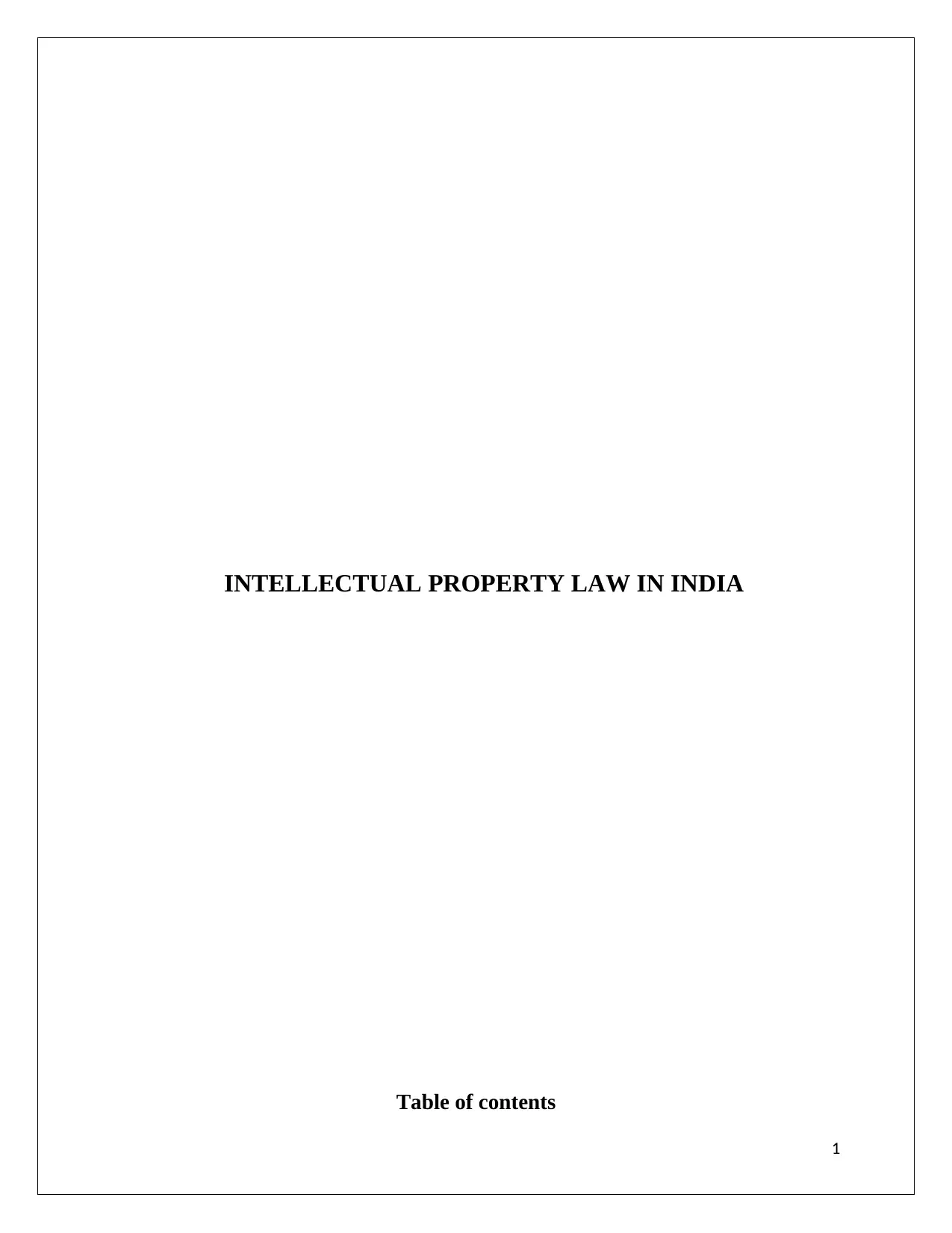
INTELLECTUAL PROPERTY LAW IN INDIA
Table of contents
1
Table of contents
1
Paraphrase This Document
Need a fresh take? Get an instant paraphrase of this document with our AI Paraphraser
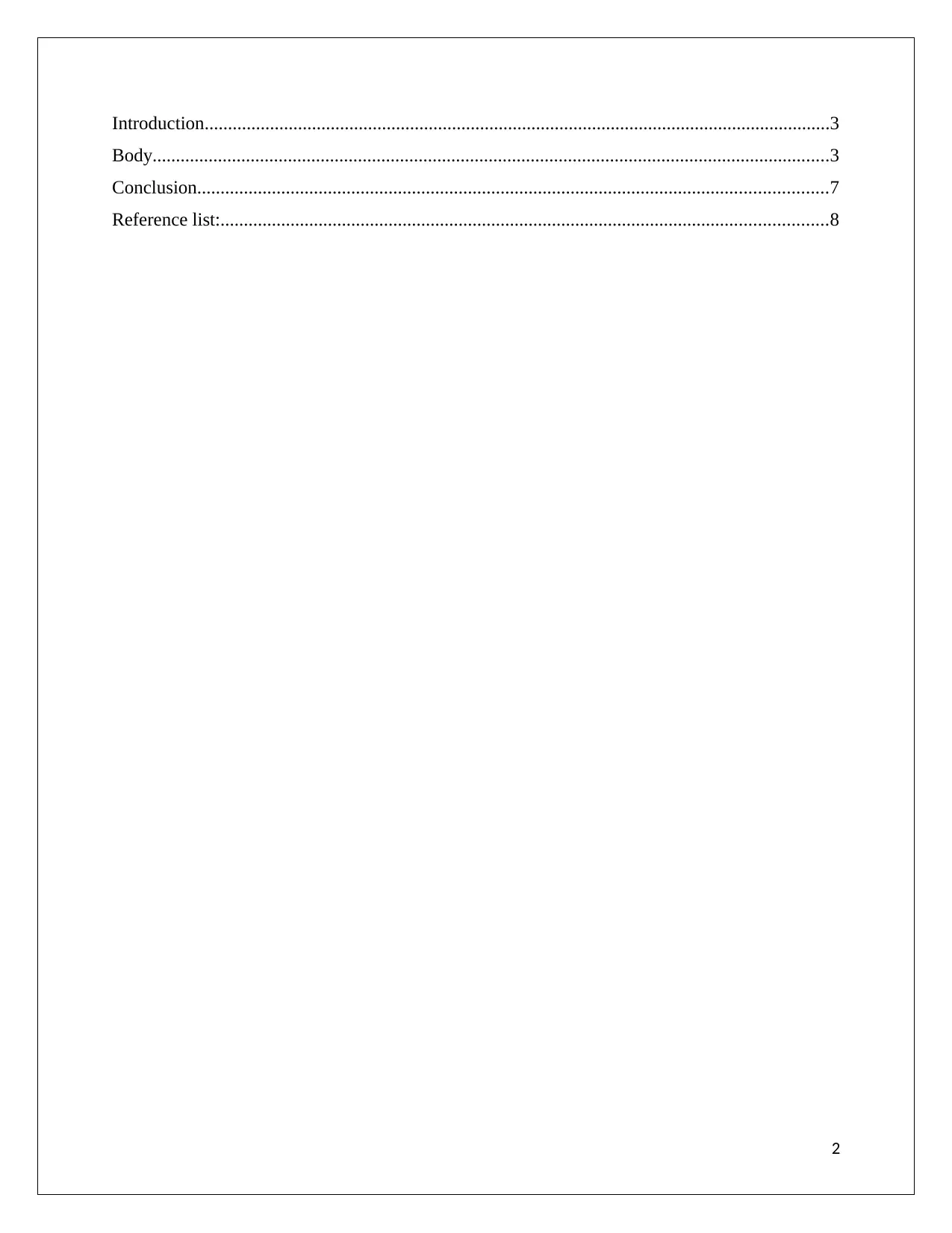
Introduction......................................................................................................................................3
Body.................................................................................................................................................3
Conclusion.......................................................................................................................................7
Reference list:..................................................................................................................................8
2
Body.................................................................................................................................................3
Conclusion.......................................................................................................................................7
Reference list:..................................................................................................................................8
2
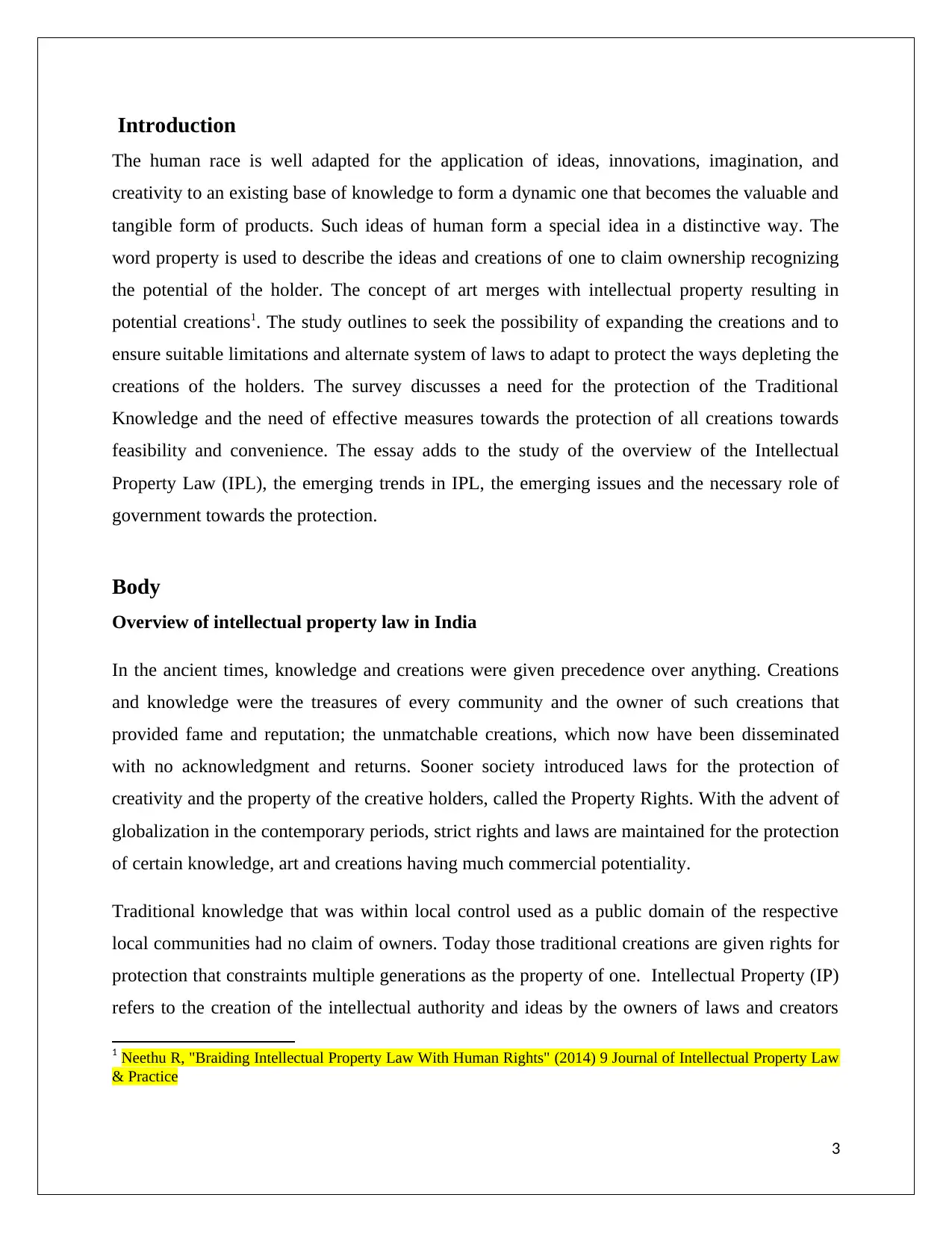
Introduction
The human race is well adapted for the application of ideas, innovations, imagination, and
creativity to an existing base of knowledge to form a dynamic one that becomes the valuable and
tangible form of products. Such ideas of human form a special idea in a distinctive way. The
word property is used to describe the ideas and creations of one to claim ownership recognizing
the potential of the holder. The concept of art merges with intellectual property resulting in
potential creations1. The study outlines to seek the possibility of expanding the creations and to
ensure suitable limitations and alternate system of laws to adapt to protect the ways depleting the
creations of the holders. The survey discusses a need for the protection of the Traditional
Knowledge and the need of effective measures towards the protection of all creations towards
feasibility and convenience. The essay adds to the study of the overview of the Intellectual
Property Law (IPL), the emerging trends in IPL, the emerging issues and the necessary role of
government towards the protection.
Body
Overview of intellectual property law in India
In the ancient times, knowledge and creations were given precedence over anything. Creations
and knowledge were the treasures of every community and the owner of such creations that
provided fame and reputation; the unmatchable creations, which now have been disseminated
with no acknowledgment and returns. Sooner society introduced laws for the protection of
creativity and the property of the creative holders, called the Property Rights. With the advent of
globalization in the contemporary periods, strict rights and laws are maintained for the protection
of certain knowledge, art and creations having much commercial potentiality.
Traditional knowledge that was within local control used as a public domain of the respective
local communities had no claim of owners. Today those traditional creations are given rights for
protection that constraints multiple generations as the property of one. Intellectual Property (IP)
refers to the creation of the intellectual authority and ideas by the owners of laws and creators
1 Neethu R, "Braiding Intellectual Property Law With Human Rights" (2014) 9 Journal of Intellectual Property Law
& Practice
3
The human race is well adapted for the application of ideas, innovations, imagination, and
creativity to an existing base of knowledge to form a dynamic one that becomes the valuable and
tangible form of products. Such ideas of human form a special idea in a distinctive way. The
word property is used to describe the ideas and creations of one to claim ownership recognizing
the potential of the holder. The concept of art merges with intellectual property resulting in
potential creations1. The study outlines to seek the possibility of expanding the creations and to
ensure suitable limitations and alternate system of laws to adapt to protect the ways depleting the
creations of the holders. The survey discusses a need for the protection of the Traditional
Knowledge and the need of effective measures towards the protection of all creations towards
feasibility and convenience. The essay adds to the study of the overview of the Intellectual
Property Law (IPL), the emerging trends in IPL, the emerging issues and the necessary role of
government towards the protection.
Body
Overview of intellectual property law in India
In the ancient times, knowledge and creations were given precedence over anything. Creations
and knowledge were the treasures of every community and the owner of such creations that
provided fame and reputation; the unmatchable creations, which now have been disseminated
with no acknowledgment and returns. Sooner society introduced laws for the protection of
creativity and the property of the creative holders, called the Property Rights. With the advent of
globalization in the contemporary periods, strict rights and laws are maintained for the protection
of certain knowledge, art and creations having much commercial potentiality.
Traditional knowledge that was within local control used as a public domain of the respective
local communities had no claim of owners. Today those traditional creations are given rights for
protection that constraints multiple generations as the property of one. Intellectual Property (IP)
refers to the creation of the intellectual authority and ideas by the owners of laws and creators
1 Neethu R, "Braiding Intellectual Property Law With Human Rights" (2014) 9 Journal of Intellectual Property Law
& Practice
3
⊘ This is a preview!⊘
Do you want full access?
Subscribe today to unlock all pages.

Trusted by 1+ million students worldwide
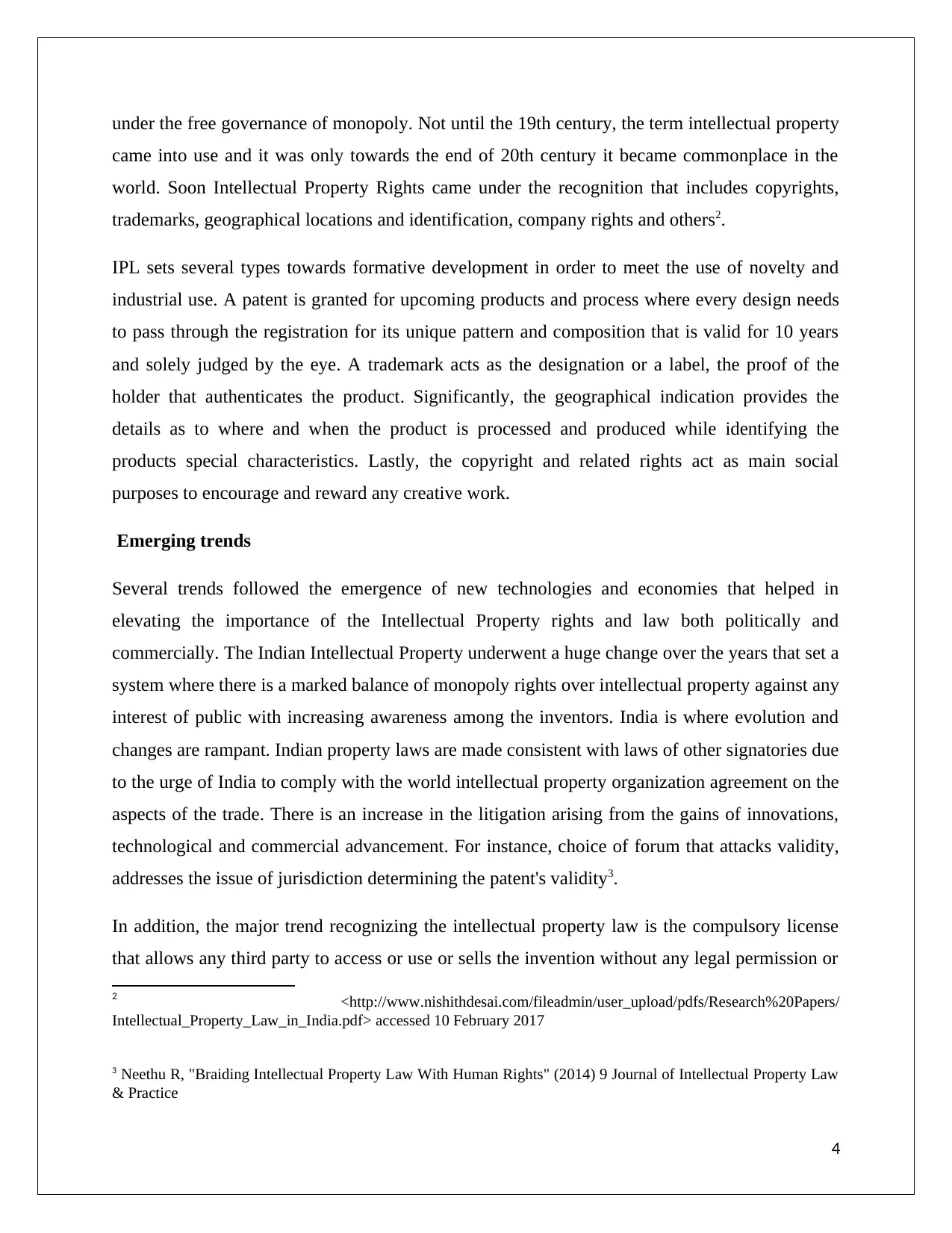
under the free governance of monopoly. Not until the 19th century, the term intellectual property
came into use and it was only towards the end of 20th century it became commonplace in the
world. Soon Intellectual Property Rights came under the recognition that includes copyrights,
trademarks, geographical locations and identification, company rights and others2.
IPL sets several types towards formative development in order to meet the use of novelty and
industrial use. A patent is granted for upcoming products and process where every design needs
to pass through the registration for its unique pattern and composition that is valid for 10 years
and solely judged by the eye. A trademark acts as the designation or a label, the proof of the
holder that authenticates the product. Significantly, the geographical indication provides the
details as to where and when the product is processed and produced while identifying the
products special characteristics. Lastly, the copyright and related rights act as main social
purposes to encourage and reward any creative work.
Emerging trends
Several trends followed the emergence of new technologies and economies that helped in
elevating the importance of the Intellectual Property rights and law both politically and
commercially. The Indian Intellectual Property underwent a huge change over the years that set a
system where there is a marked balance of monopoly rights over intellectual property against any
interest of public with increasing awareness among the inventors. India is where evolution and
changes are rampant. Indian property laws are made consistent with laws of other signatories due
to the urge of India to comply with the world intellectual property organization agreement on the
aspects of the trade. There is an increase in the litigation arising from the gains of innovations,
technological and commercial advancement. For instance, choice of forum that attacks validity,
addresses the issue of jurisdiction determining the patent's validity3.
In addition, the major trend recognizing the intellectual property law is the compulsory license
that allows any third party to access or use or sells the invention without any legal permission or
2 <http://www.nishithdesai.com/fileadmin/user_upload/pdfs/Research%20Papers/
Intellectual_Property_Law_in_India.pdf> accessed 10 February 2017
3 Neethu R, "Braiding Intellectual Property Law With Human Rights" (2014) 9 Journal of Intellectual Property Law
& Practice
4
came into use and it was only towards the end of 20th century it became commonplace in the
world. Soon Intellectual Property Rights came under the recognition that includes copyrights,
trademarks, geographical locations and identification, company rights and others2.
IPL sets several types towards formative development in order to meet the use of novelty and
industrial use. A patent is granted for upcoming products and process where every design needs
to pass through the registration for its unique pattern and composition that is valid for 10 years
and solely judged by the eye. A trademark acts as the designation or a label, the proof of the
holder that authenticates the product. Significantly, the geographical indication provides the
details as to where and when the product is processed and produced while identifying the
products special characteristics. Lastly, the copyright and related rights act as main social
purposes to encourage and reward any creative work.
Emerging trends
Several trends followed the emergence of new technologies and economies that helped in
elevating the importance of the Intellectual Property rights and law both politically and
commercially. The Indian Intellectual Property underwent a huge change over the years that set a
system where there is a marked balance of monopoly rights over intellectual property against any
interest of public with increasing awareness among the inventors. India is where evolution and
changes are rampant. Indian property laws are made consistent with laws of other signatories due
to the urge of India to comply with the world intellectual property organization agreement on the
aspects of the trade. There is an increase in the litigation arising from the gains of innovations,
technological and commercial advancement. For instance, choice of forum that attacks validity,
addresses the issue of jurisdiction determining the patent's validity3.
In addition, the major trend recognizing the intellectual property law is the compulsory license
that allows any third party to access or use or sells the invention without any legal permission or
2 <http://www.nishithdesai.com/fileadmin/user_upload/pdfs/Research%20Papers/
Intellectual_Property_Law_in_India.pdf> accessed 10 February 2017
3 Neethu R, "Braiding Intellectual Property Law With Human Rights" (2014) 9 Journal of Intellectual Property Law
& Practice
4
Paraphrase This Document
Need a fresh take? Get an instant paraphrase of this document with our AI Paraphraser
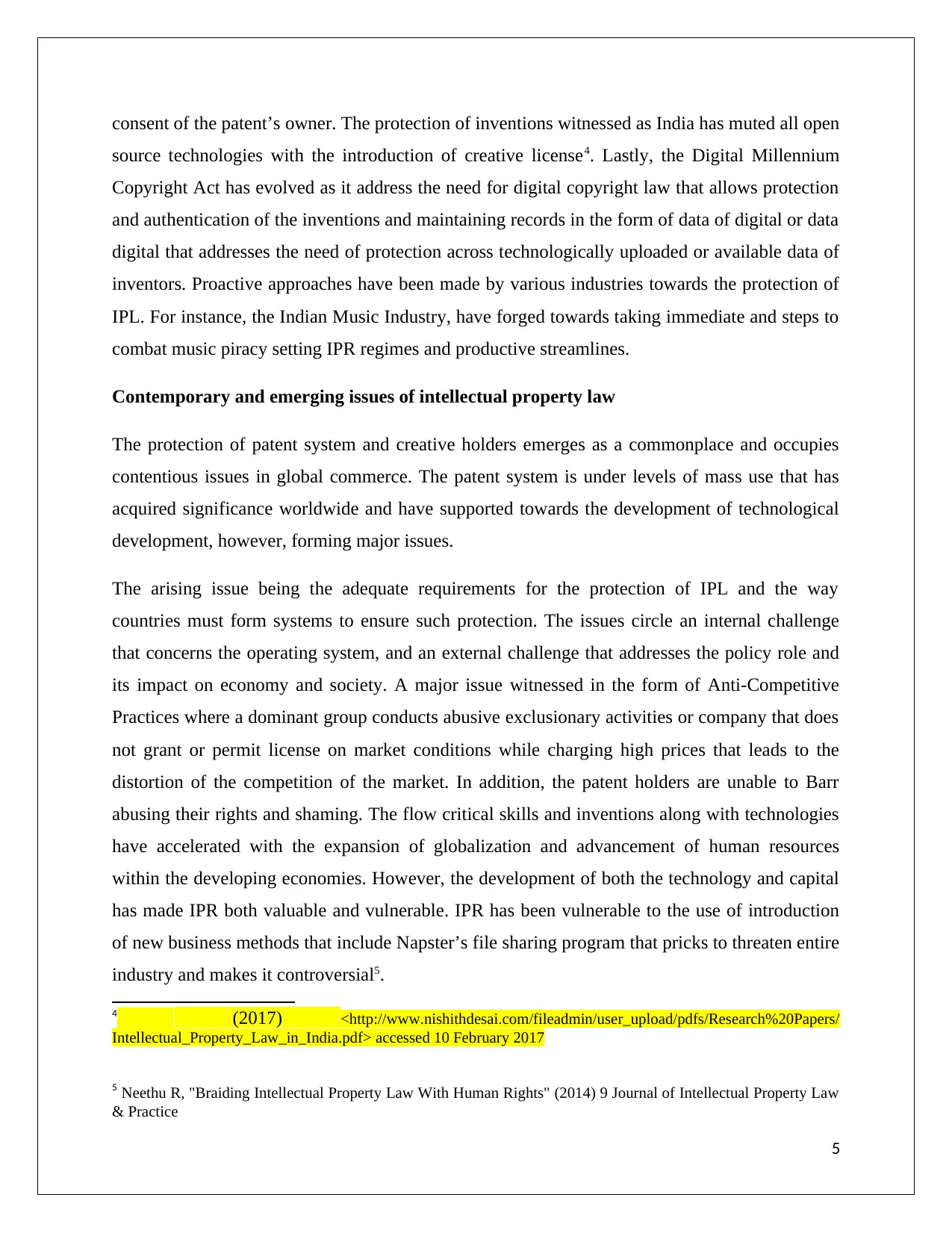
consent of the patent’s owner. The protection of inventions witnessed as India has muted all open
source technologies with the introduction of creative license4. Lastly, the Digital Millennium
Copyright Act has evolved as it address the need for digital copyright law that allows protection
and authentication of the inventions and maintaining records in the form of data of digital or data
digital that addresses the need of protection across technologically uploaded or available data of
inventors. Proactive approaches have been made by various industries towards the protection of
IPL. For instance, the Indian Music Industry, have forged towards taking immediate and steps to
combat music piracy setting IPR regimes and productive streamlines.
Contemporary and emerging issues of intellectual property law
The protection of patent system and creative holders emerges as a commonplace and occupies
contentious issues in global commerce. The patent system is under levels of mass use that has
acquired significance worldwide and have supported towards the development of technological
development, however, forming major issues.
The arising issue being the adequate requirements for the protection of IPL and the way
countries must form systems to ensure such protection. The issues circle an internal challenge
that concerns the operating system, and an external challenge that addresses the policy role and
its impact on economy and society. A major issue witnessed in the form of Anti-Competitive
Practices where a dominant group conducts abusive exclusionary activities or company that does
not grant or permit license on market conditions while charging high prices that leads to the
distortion of the competition of the market. In addition, the patent holders are unable to Barr
abusing their rights and shaming. The flow critical skills and inventions along with technologies
have accelerated with the expansion of globalization and advancement of human resources
within the developing economies. However, the development of both the technology and capital
has made IPR both valuable and vulnerable. IPR has been vulnerable to the use of introduction
of new business methods that include Napster’s file sharing program that pricks to threaten entire
industry and makes it controversial5.
4 (2017) <http://www.nishithdesai.com/fileadmin/user_upload/pdfs/Research%20Papers/
Intellectual_Property_Law_in_India.pdf> accessed 10 February 2017
5 Neethu R, "Braiding Intellectual Property Law With Human Rights" (2014) 9 Journal of Intellectual Property Law
& Practice
5
source technologies with the introduction of creative license4. Lastly, the Digital Millennium
Copyright Act has evolved as it address the need for digital copyright law that allows protection
and authentication of the inventions and maintaining records in the form of data of digital or data
digital that addresses the need of protection across technologically uploaded or available data of
inventors. Proactive approaches have been made by various industries towards the protection of
IPL. For instance, the Indian Music Industry, have forged towards taking immediate and steps to
combat music piracy setting IPR regimes and productive streamlines.
Contemporary and emerging issues of intellectual property law
The protection of patent system and creative holders emerges as a commonplace and occupies
contentious issues in global commerce. The patent system is under levels of mass use that has
acquired significance worldwide and have supported towards the development of technological
development, however, forming major issues.
The arising issue being the adequate requirements for the protection of IPL and the way
countries must form systems to ensure such protection. The issues circle an internal challenge
that concerns the operating system, and an external challenge that addresses the policy role and
its impact on economy and society. A major issue witnessed in the form of Anti-Competitive
Practices where a dominant group conducts abusive exclusionary activities or company that does
not grant or permit license on market conditions while charging high prices that leads to the
distortion of the competition of the market. In addition, the patent holders are unable to Barr
abusing their rights and shaming. The flow critical skills and inventions along with technologies
have accelerated with the expansion of globalization and advancement of human resources
within the developing economies. However, the development of both the technology and capital
has made IPR both valuable and vulnerable. IPR has been vulnerable to the use of introduction
of new business methods that include Napster’s file sharing program that pricks to threaten entire
industry and makes it controversial5.
4 (2017) <http://www.nishithdesai.com/fileadmin/user_upload/pdfs/Research%20Papers/
Intellectual_Property_Law_in_India.pdf> accessed 10 February 2017
5 Neethu R, "Braiding Intellectual Property Law With Human Rights" (2014) 9 Journal of Intellectual Property Law
& Practice
5
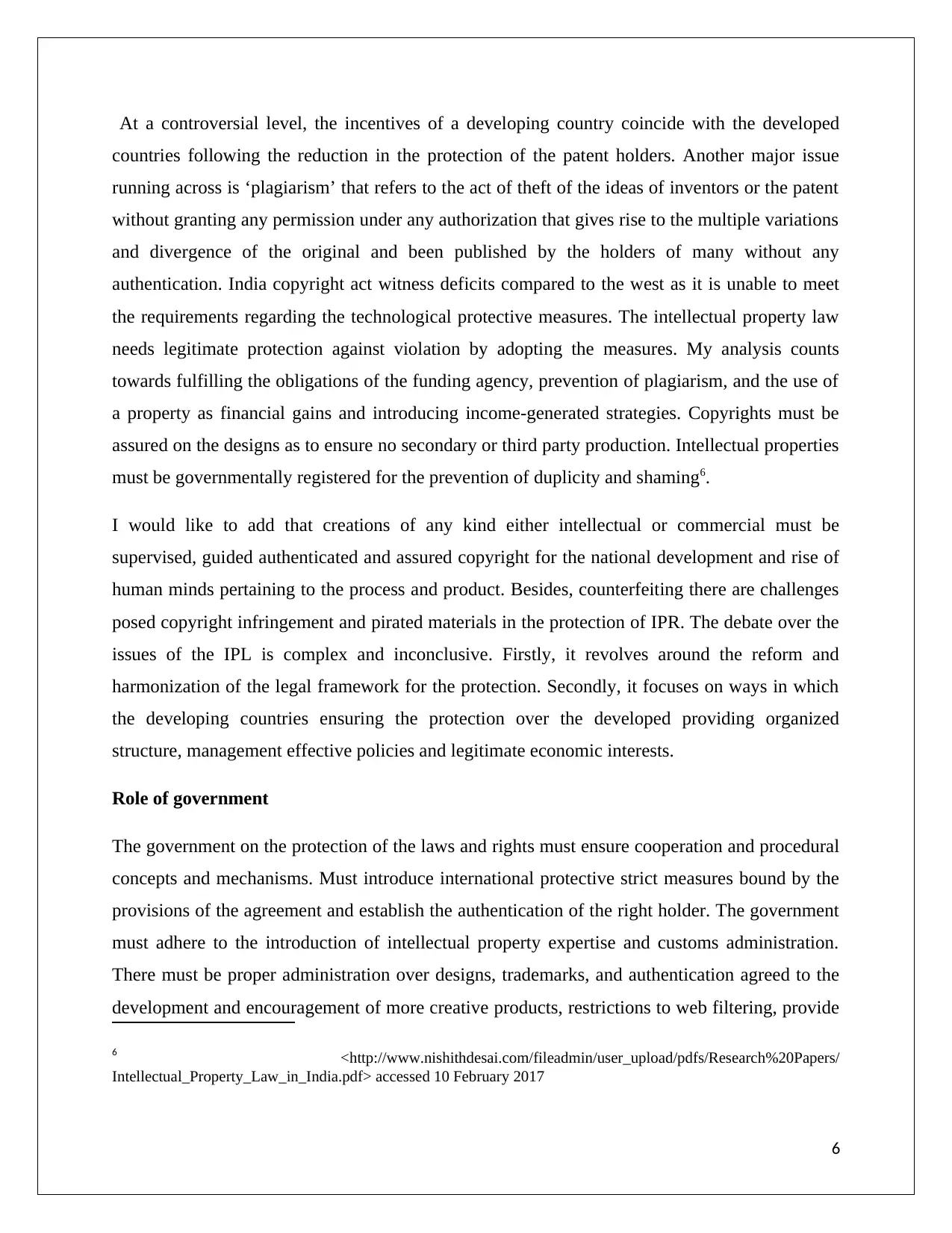
At a controversial level, the incentives of a developing country coincide with the developed
countries following the reduction in the protection of the patent holders. Another major issue
running across is ‘plagiarism’ that refers to the act of theft of the ideas of inventors or the patent
without granting any permission under any authorization that gives rise to the multiple variations
and divergence of the original and been published by the holders of many without any
authentication. India copyright act witness deficits compared to the west as it is unable to meet
the requirements regarding the technological protective measures. The intellectual property law
needs legitimate protection against violation by adopting the measures. My analysis counts
towards fulfilling the obligations of the funding agency, prevention of plagiarism, and the use of
a property as financial gains and introducing income-generated strategies. Copyrights must be
assured on the designs as to ensure no secondary or third party production. Intellectual properties
must be governmentally registered for the prevention of duplicity and shaming6.
I would like to add that creations of any kind either intellectual or commercial must be
supervised, guided authenticated and assured copyright for the national development and rise of
human minds pertaining to the process and product. Besides, counterfeiting there are challenges
posed copyright infringement and pirated materials in the protection of IPR. The debate over the
issues of the IPL is complex and inconclusive. Firstly, it revolves around the reform and
harmonization of the legal framework for the protection. Secondly, it focuses on ways in which
the developing countries ensuring the protection over the developed providing organized
structure, management effective policies and legitimate economic interests.
Role of government
The government on the protection of the laws and rights must ensure cooperation and procedural
concepts and mechanisms. Must introduce international protective strict measures bound by the
provisions of the agreement and establish the authentication of the right holder. The government
must adhere to the introduction of intellectual property expertise and customs administration.
There must be proper administration over designs, trademarks, and authentication agreed to the
development and encouragement of more creative products, restrictions to web filtering, provide
6 <http://www.nishithdesai.com/fileadmin/user_upload/pdfs/Research%20Papers/
Intellectual_Property_Law_in_India.pdf> accessed 10 February 2017
6
countries following the reduction in the protection of the patent holders. Another major issue
running across is ‘plagiarism’ that refers to the act of theft of the ideas of inventors or the patent
without granting any permission under any authorization that gives rise to the multiple variations
and divergence of the original and been published by the holders of many without any
authentication. India copyright act witness deficits compared to the west as it is unable to meet
the requirements regarding the technological protective measures. The intellectual property law
needs legitimate protection against violation by adopting the measures. My analysis counts
towards fulfilling the obligations of the funding agency, prevention of plagiarism, and the use of
a property as financial gains and introducing income-generated strategies. Copyrights must be
assured on the designs as to ensure no secondary or third party production. Intellectual properties
must be governmentally registered for the prevention of duplicity and shaming6.
I would like to add that creations of any kind either intellectual or commercial must be
supervised, guided authenticated and assured copyright for the national development and rise of
human minds pertaining to the process and product. Besides, counterfeiting there are challenges
posed copyright infringement and pirated materials in the protection of IPR. The debate over the
issues of the IPL is complex and inconclusive. Firstly, it revolves around the reform and
harmonization of the legal framework for the protection. Secondly, it focuses on ways in which
the developing countries ensuring the protection over the developed providing organized
structure, management effective policies and legitimate economic interests.
Role of government
The government on the protection of the laws and rights must ensure cooperation and procedural
concepts and mechanisms. Must introduce international protective strict measures bound by the
provisions of the agreement and establish the authentication of the right holder. The government
must adhere to the introduction of intellectual property expertise and customs administration.
There must be proper administration over designs, trademarks, and authentication agreed to the
development and encouragement of more creative products, restrictions to web filtering, provide
6 <http://www.nishithdesai.com/fileadmin/user_upload/pdfs/Research%20Papers/
Intellectual_Property_Law_in_India.pdf> accessed 10 February 2017
6
⊘ This is a preview!⊘
Do you want full access?
Subscribe today to unlock all pages.

Trusted by 1+ million students worldwide
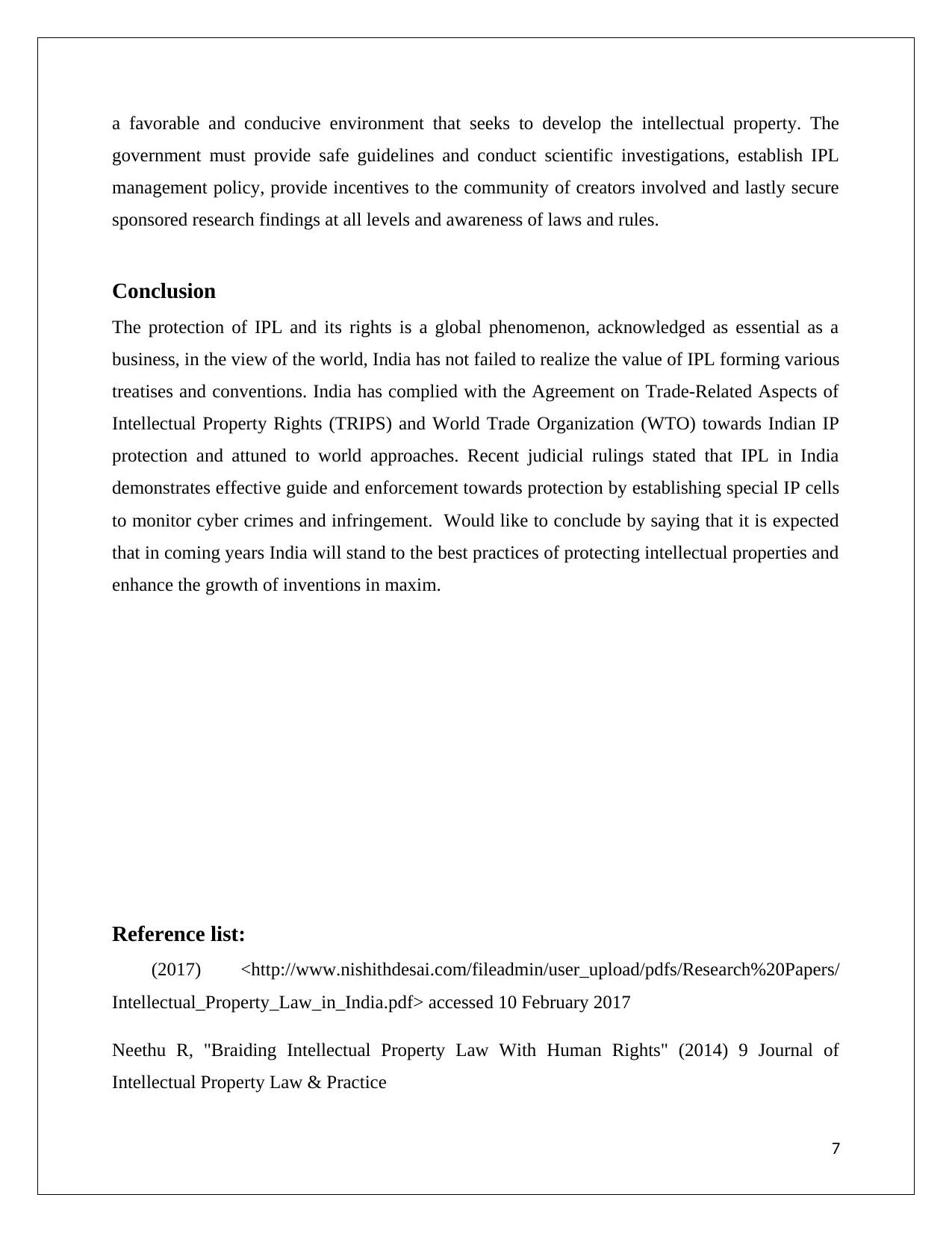
a favorable and conducive environment that seeks to develop the intellectual property. The
government must provide safe guidelines and conduct scientific investigations, establish IPL
management policy, provide incentives to the community of creators involved and lastly secure
sponsored research findings at all levels and awareness of laws and rules.
Conclusion
The protection of IPL and its rights is a global phenomenon, acknowledged as essential as a
business, in the view of the world, India has not failed to realize the value of IPL forming various
treatises and conventions. India has complied with the Agreement on Trade-Related Aspects of
Intellectual Property Rights (TRIPS) and World Trade Organization (WTO) towards Indian IP
protection and attuned to world approaches. Recent judicial rulings stated that IPL in India
demonstrates effective guide and enforcement towards protection by establishing special IP cells
to monitor cyber crimes and infringement. Would like to conclude by saying that it is expected
that in coming years India will stand to the best practices of protecting intellectual properties and
enhance the growth of inventions in maxim.
Reference list:
(2017) <http://www.nishithdesai.com/fileadmin/user_upload/pdfs/Research%20Papers/
Intellectual_Property_Law_in_India.pdf> accessed 10 February 2017
Neethu R, "Braiding Intellectual Property Law With Human Rights" (2014) 9 Journal of
Intellectual Property Law & Practice
7
government must provide safe guidelines and conduct scientific investigations, establish IPL
management policy, provide incentives to the community of creators involved and lastly secure
sponsored research findings at all levels and awareness of laws and rules.
Conclusion
The protection of IPL and its rights is a global phenomenon, acknowledged as essential as a
business, in the view of the world, India has not failed to realize the value of IPL forming various
treatises and conventions. India has complied with the Agreement on Trade-Related Aspects of
Intellectual Property Rights (TRIPS) and World Trade Organization (WTO) towards Indian IP
protection and attuned to world approaches. Recent judicial rulings stated that IPL in India
demonstrates effective guide and enforcement towards protection by establishing special IP cells
to monitor cyber crimes and infringement. Would like to conclude by saying that it is expected
that in coming years India will stand to the best practices of protecting intellectual properties and
enhance the growth of inventions in maxim.
Reference list:
(2017) <http://www.nishithdesai.com/fileadmin/user_upload/pdfs/Research%20Papers/
Intellectual_Property_Law_in_India.pdf> accessed 10 February 2017
Neethu R, "Braiding Intellectual Property Law With Human Rights" (2014) 9 Journal of
Intellectual Property Law & Practice
7
Paraphrase This Document
Need a fresh take? Get an instant paraphrase of this document with our AI Paraphraser

8
1 out of 8
Related Documents
Your All-in-One AI-Powered Toolkit for Academic Success.
+13062052269
info@desklib.com
Available 24*7 on WhatsApp / Email
![[object Object]](/_next/static/media/star-bottom.7253800d.svg)
Unlock your academic potential
Copyright © 2020–2025 A2Z Services. All Rights Reserved. Developed and managed by ZUCOL.




